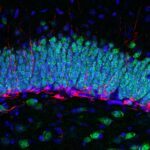Link to Pubmed [PMID] – 30106966
PLoS Comput. Biol. 2018 08;14(8):e1006320
The hippocampus is known to store cognitive representations, or maps, that encode both positional and contextual information, critical for episodic memories and functional behavior. How path integration and contextual cues are dynamically combined and processed by the hippocampus to maintain these representations accurate over time remains unclear. To answer this question, we propose a two-way data analysis and modeling approach to CA3 multi-electrode recordings of a moving rat submitted to rapid changes of contextual (light) cues, triggering back-and-forth instabitilies between two cognitive representations (“teleportation” experiment of Jezek et al). We develop a dual neural activity decoder, capable of independently identifying the recalled cognitive map at high temporal resolution (comparable to theta cycle) and the position of the rodent given a map. Remarkably, position can be reconstructed at any time with an accuracy comparable to fixed-context periods, even during highly unstable periods. These findings provide evidence for the capability of the hippocampal neural activity to maintain an accurate encoding of spatial and contextual variables, while one of these variables undergoes rapid changes independently of the other. To explain this result we introduce an attractor neural network model for the hippocampal activity that process inputs from external cues and the path integrator. Our model allows us to make predictions on the frequency of the cognitive map instability, its duration, and the detailed nature of the place-cell population activity, which are validated by a further analysis of the data. Our work therefore sheds light on the mechanisms by which the hippocampal network achieves and updates multi-dimensional neural representations from various input streams.

